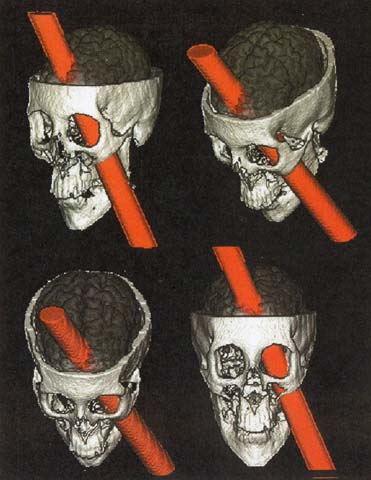In 1848, Phineas Gage, an American railroad worker, was impaled through the skull by a 43-inchlong tamping iron when the explosives he was working with went off prematurely.
1848年,美国铁路工人菲尼亚斯·盖奇工作时,爆炸物过早引爆,导致他被一根43英寸长的铁夯刺穿头骨。
He survived, but his personality was permanently altered.
他活了下来,但性格却发生了永久性地改变。
In a paper titled "Recovery From the Passage of an Iron Bar Through the Head," his doctor wrote that Gage's "animal propensities" had emerged and described him as using the "grossest profanity."
在一篇题为《经历铁棒穿过头部后的恢复》的论文中,他的医生写道,盖奇显露出“动物倾向”,并描述他使用“最粗俗的脏话”。
Modern research has shown that the tamping iron destroyed key areas of the brain involved in inhibition—the same areas that were altered in the depressed patients who'd committed suicide.
现代研究表明,铁夯破坏了大脑中与抑制有关的关键区域,这些区域与自杀的抑郁症患者发生改变的脑区相同。
For the group, this was a clue that the differences in the brain of suicidal patients were anatomically important.
对他们来说,这是一个线索,它表明自杀患者大脑的差异在解剖学上是重要的。
"Most people inhibit suicide. They find a reason not to do it," Underwood says.
“大多数人都会抑制住自杀,能找到不这么做的理由,”安德伍德说。
Thanks to subtle changes in the part of the brain that might normally control inhibition and top-down control, people who kill themselves "don't find a reason not to do it," he says.
由于大脑中通常控制抑制和自上而下控制的部分发生细微变化,自杀的人“找不到不这么做的理由”。
About eight years ago, Mann saw ketamine research taking off in other corners of the scientific world and added the drug to his own work.
大约八年前,曼恩看到氯胺酮的研究在科学界的其他领域取得了进展,就把这种药物加到自己的研究中。
In one trial, his group found that ketamine treatment could ease suicidal thoughts in 24 hours more effectively than a control drug.
在一项试验中,他的研究小组发现氯胺酮治疗与对照药物相比,能在24小时内更有效地缓解自杀念头。

Crucially, they found that the antisuicidal effects of ketamine were to some extent independent of the antidepressant effect of the drug, 关键是,他们发现氯胺酮的抗自杀作用在某种程度上独立于药物的抗抑郁作用,
which helped support their thesis that suicidal impulses aren't necessarily just a byproduct of depression.
这有助于支持他们的观点,即自杀冲动不一定只是抑郁症的副产物。
It was this study, led by Michael Grunebaum, a colleague of Mann's, that made a believer of Joe Wright.
正是这项由曼恩的同事迈克尔·格伦鲍姆负责的研究,使乔·赖特相信了这种观点。
In 2000, the National Institutes of Health hired Charney to run both mood disorder and experimental drug research. It was the perfect place for him to forge ahead with ketamine.
2000年,美国国家卫生研究院(NIH)聘请查尼进行情绪障碍和实验药物研究,这是他采用氯胺酮推进研究的理想之地。
There he did the work to replicate what he and his colleagues at Yale had discovered.
他在那里进行研究,再造了他和耶鲁大学的同事们发现的研究结果。
In a study published in 2006, led by researcher Carlos Zarate Jr., who now oversees NIH studies of ketamine and suicidality, an NIH team found that patients had "robust and rapid antidepressant effects" from a single dose of the drug within two hours.
小卡洛斯·扎拉特目前负责监督NIH对氯胺酮和自杀的研究,在2006年发表的一项研究中,由他负责的研究小组发现,患者在两小时内单次用药会产生“强劲又快速的抗抑郁作用”。
"We could not believe it. In the first few subjects we were like, 'Oh, you can always find one patient or two who gets better,'" Zarate recalls.
扎拉特回忆道:“我们无法相信这个结果。对于前几个被试,我们会说,‘哦,总能找到一两个病情好转的病人。’”
In a 2009 study done at Mount Sinai, patients suffering from treatment-resistant depression showed rapid improvement in suicidal thinking within 24 hours.
2009年在西奈山进行的一项研究中,患有抗治疗抑郁症的患者在24小时内自杀性思维迅速出现改善。
The next year, Zarate's group demonstrated antisuicidal effects within 40 minutes. "That you could replicate the findings, the rapid findings, was quite eerie," Zarate says.
第二年,扎拉特的研究小组证实了该药在40分钟内的抗自杀效果。“可以重复求证这些研究结果,见效速度非常快,相当奇怪,”扎拉特说。













